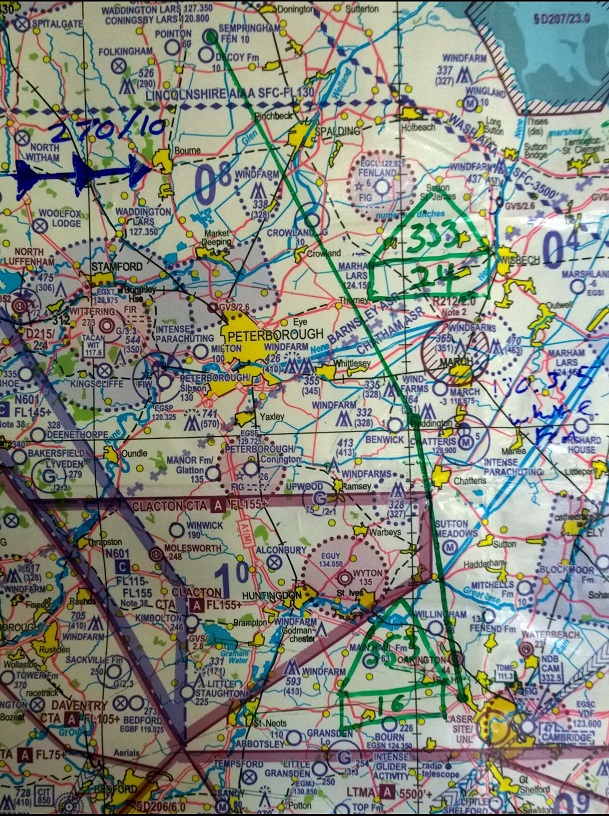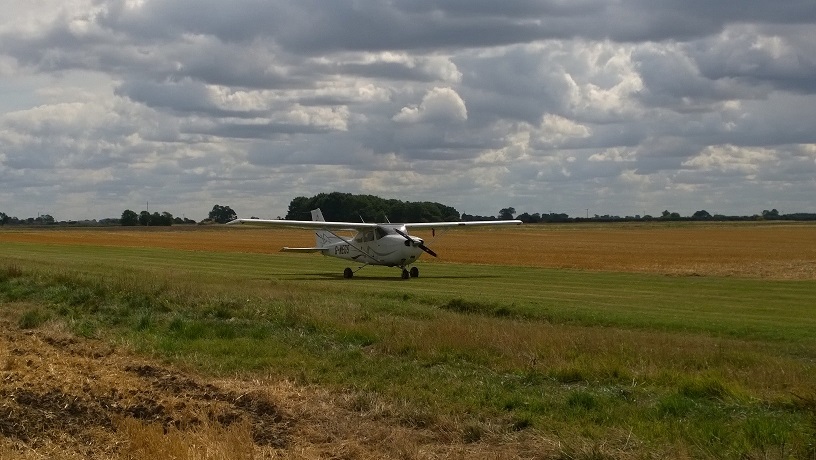The general scheme for this course is 1 hour revision, 1 hour land-away and finally an afternoon of land-aways. Part #2 got scrapped due to weather, but thankfully the instructor said we could progress to the final part, do the afternoon of challenging farm strips and if I had no issues with them, he’d consider it a done deal and I’d be free to go fly farm strips on my own. Time to impress then!
The weather was looking great, so no excuses.
Briefing and the Afternoon Plan
No PLOG for this trip, everything on the map again, general plan of attack was to fly up to White Fen farm (not even on the chart!) for a full stop landing, but we wouldn’t get out, then up to Sempringam Fen Farm for a touch and go and a full stop landing.
Neither strip is very big, ~470m x 16m
What makes farm strip flying interesting to me is if you crack open the C172 SP Pilot Operating Handbook a little bit of math will tell you that the plane won’t stop at full weight and zero wind in anything under ~580m. So you can count these places out if you plan to tank up and take the family, to get into them less fuel is good and fewer passengers, even better.
White Fen Farm
Because this blog post is much delayed, I can tell you that farm strips aren’t always easy to find even with the advances of Google Earth. Even now I find it essentially impossible to pin point you to where this place is. Probably a good thing.
With about 2 nautical miles to run I finally spotted the place from the air. East Anglia is flat and a shade of green/yellow almost everywhere that isn’t a town. So spotting ~500m of straight grass amongst a sea of grass is harder then it sounds! That said, I can think back to when I first started to learn to fly and instructors would ask if I could see Cambridge from 7nm out, forget it! Today I’m so used to the shapes of airfields I look back wondering how I ever missed it, but experience teaches you what to look for.
Making radio calls on a safety com frequency as we joined “the circuit”, to no reply, I really focused on making sure I got my downwind/pre-landing checks in and then really put the effort in to ensure a good circuit, good height and to not turn on to the base leg until I was sure I’d have enough distance on final to get it down in one go. They were kind enough to let me come and land at their farm, the last thing they need is a C172 buzzing the house on go-arounds if I could avoid it.
My top tip is to not turn base until the runway threshold is just about to disappear out of the rear side window. If you fly a circuit of about 0.5nm (1km), this should give you, rough numbers, just under 0.5nm final approach which should work, without buzzing the next village down the road etc. Any sooner and you’ll be trying a military continuous circuit and your workload will sky rocket, any later and as I said you’ll probably just upset the owners neighbors and never be invited back 🙁
Taking care to not come in short, but also not hit the tree on the right it was a pretty nice touch down. I think if I could do it again I’d like to have touched down maybe 50m sooner, but I was happy with my airspeed control and the landing was controlled and not slammed. Tick in a box.
We taxied down to the far end and due to the light winds take-off direction was much of a muchness, so just spun it around at the other end. 10 degrees of flap for best short field performance, brakes on and throttled up to 2,000 rpm. One last check the instructor was happy, then release the brakes and charge down the grass strip.
Airspeed Indicator comes alive, now it’s about judging how fast the airspeed indicator is increasing relative to how much grass we have left. By a quarter of the runway gone, we were well on our way to rotation speed, so it was looking good. 55 knots, rotate and climb away at best angle (Vx) of climb rather than best rate (Vy) – we care about not hitting the trees, not how fast we can get to 1,000ft 🙂
Onwards to Sempringham Fen Farm Strip
Spotting this one was probably going to be harder and worth remembering that my dead-reckoning and wind calculations were all done on the Chart with Max Drift estimations so weren’t going to be spot on. What I knew from my map was that I’d have Spalding on the right, if I overflew it I was too far right of track, if it was somewhere off to the right in the distance, I’d be to far left. I also knew that there was a railway line that came out of Spalding and curved round to the west, if I overflew that then I’d gone too far north – I didn’t think the instructor would let that happen, but I was trying to come up with a plan to narrow down the big flat world outside. Being really optimistic I knew the route crossed South Forty Foot Drain running north/south – I was hoping I’d spot that, if I spotted the crossing for that drain, Sempringham would be on my left.
Of course all best laid plans……I knew I was ball park in the right area, but ~4nm out I couldn’t see it, with hindsight I think I was a little fixated on the idea that it would be in front of me (being a bit optimistic about flying a perfect heading perhaps!). The instructor asked if I gave up and wanted him to point it out to me? Ok I give up.
Pointing to the left, about 4-5 nm away was what to me at the time looked like the thinnest strip of grass ever. You’re joking that’s an airfield right? It was straight and with a house & barn at the end it was the right sort of shape, but as we got closer, from 2,000ft it still looked incredibly narrow – even if we forget the length!
Impress or fail, we’d have our answer in a few minutes.
Setting up the circuit, I saw a good north/south ditch type thing to the east of the strip that I decided to use as a reference for the base leg. I didn’t want to fly a silly sized circuit, but I didn’t want to turn and find myself halfway down the grass strip at 600ft either, this ditch seemed like a good sized compromise to a reasonable circuit shape.
On approach my eyes and brain were working overdrive on airspeed and watching the window. Window, Airspeed, Window, Airspeed. I took one comment from the instructor to just keep my airspeed up a little as I went through 60 knots – wind consideration here is critical, light winds need as much consideration as gusting etc. Even so, I was really trying my hardest to put this plane down right at the very start of the strip.
Just going through 50ft the plane sank, I jumped on it and applied a little throttle to counter, caught it beautifully and it corrected just nicely enough to be able to take it back off again and touch down only feet from the start of the runway. I couldn’t have been happier with it.
Full power, tons of runway left, which is saying something as it’s only 460m end to end!
Another circuit and again I really wanted a spot on landing for the full stop, just to show it was no fluke.
I used the same circuit points as before, they seemed to work out nicely and again went for ensuring I was totally in control of my airspeed on the approach with a constant picture out of the window. Pointing the plane at just a few feet before the start of the strip for where I wanted the plane to go and using the throttle to keep the airspeed in check – I was still getting the hang of point and power technique, but having done only a few landings using it, I can assure you that post learning, it’s really the way to do it if you want accuracy.
Touch down, nice and soft and right where I wanted it to go at the beginning of the runway, we were down to taxi speed with around half the strip to go.
I chalk this one up as probably the best landing I’ve ever done.
The best places to land involve those places that have coffee and cake, with much thanks, both were on offer. Flying, cake and coffee – I see your hobby and raise you, it doesn’t get any better then this 🙂
Back to Cambridge
Another short field take off and it was off for a really quite pleasant flight back to Cambridge, funny really that some months ago Spalding/Cambridge was a route on one of my first solo Nav’s and I must have concentrated soooo hard to not miss Spalding. Now I was just glancing at the map, spotting the land marks and really flying with my eyes out of the window just enjoying the views and a casual chat on the way home.
Great day to be flying.
Back on the ground at Cambridge the chief flying instructor said he was happy with my flying and didn’t need to see any more. My training record now shows I’m cleared to fly the club aeroplanes into farm strips!
Farm Strips: I’m hooked, more!
It’s been one of the best courses, different to when you’re trying to be formally taught how to fly. Yet challenging and I really feel I expanded by skill set from doing it. Not just in terms of flying, but also increasing my confidence to try find and go into shorter strips on my own, with the right training to be able to do it safely.
Hand on heart, I find myself completely hooked on flying farm strips now.
I’ve done a bunch of big runway landings, I trained at one etc. Big airfields bring different things to the party, lots of radio work, procedural joins and accurate circuit flying being critical etc. but for the challenge of the landing and even the challenge of finding some little patch of grass in the middle of nowhere. I found myself wanting to just get out there and do more farm strips – I started to wonder who might let me come land in their garden if I asked nicely enough 🙂

